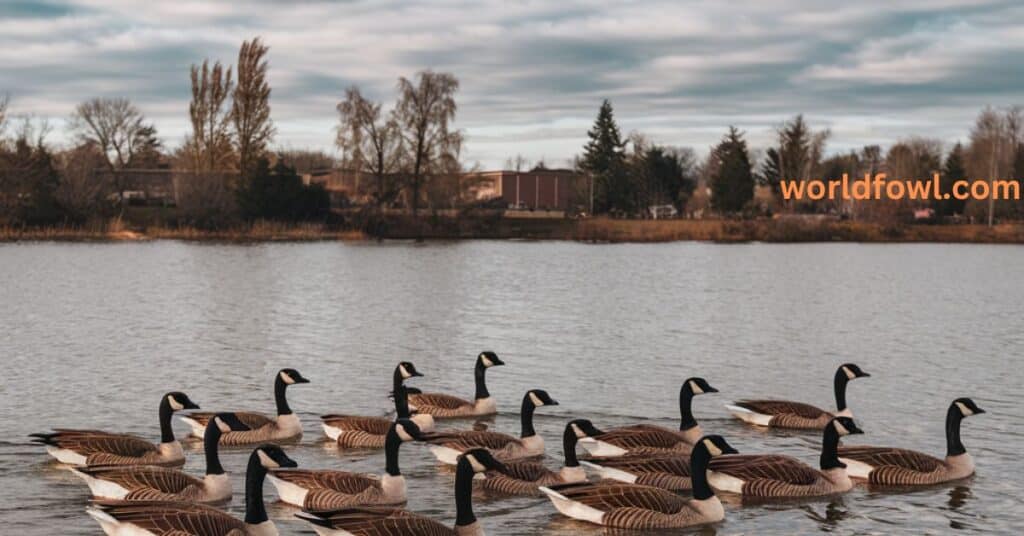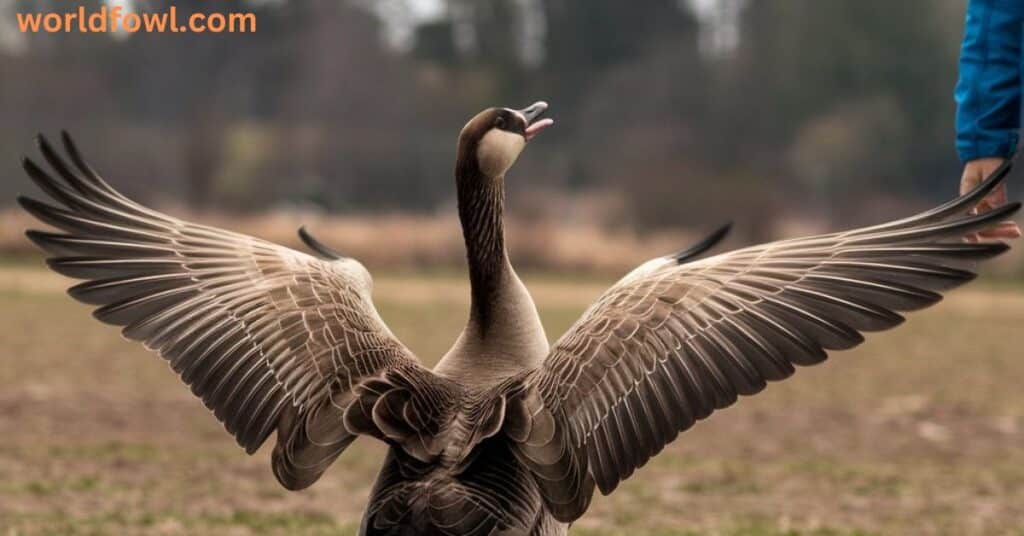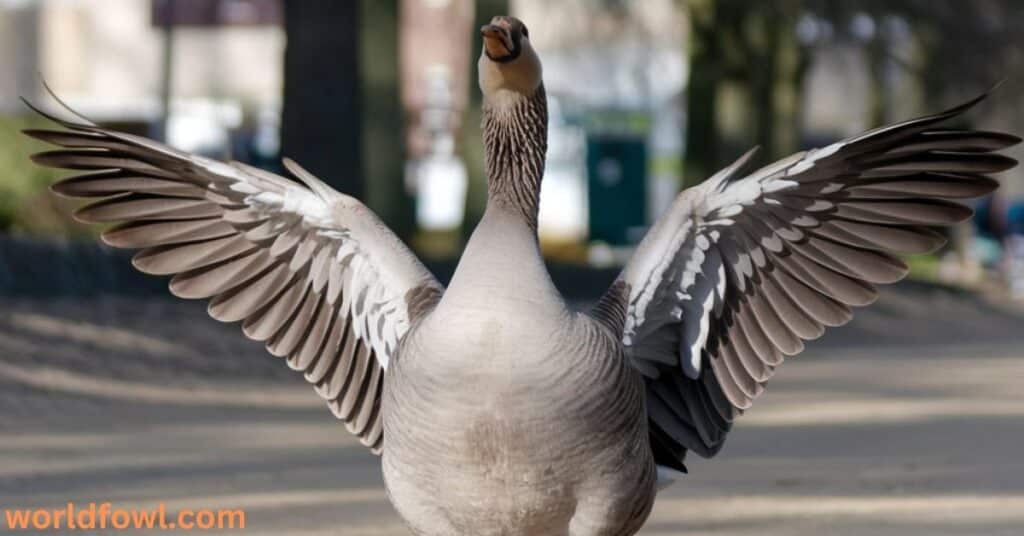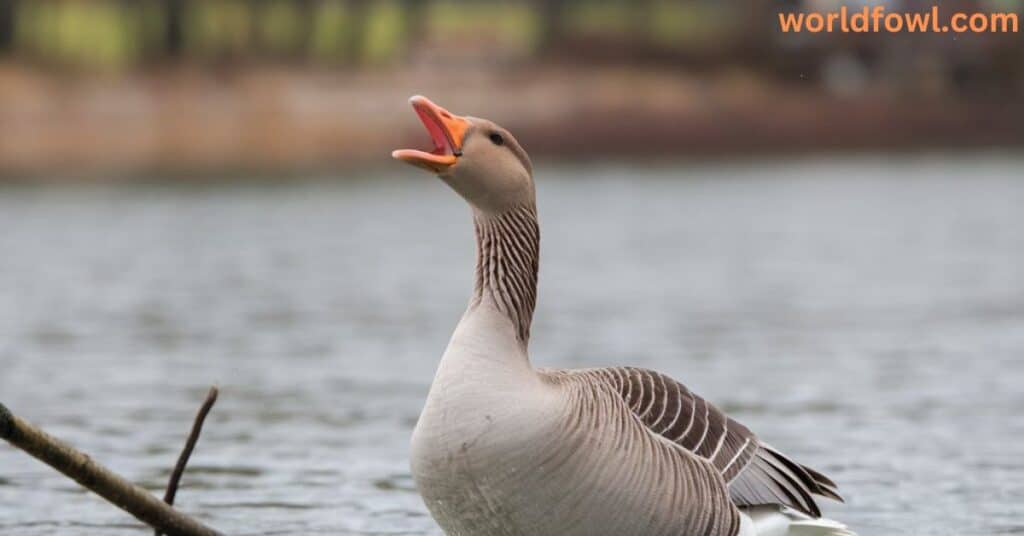When you think of geese, you probably picture a peaceful flock gliding across a serene pond or migrating high above. However, as many urban dwellers and nature enthusiasts know, geese can become surprisingly aggressive under certain circumstances. So, the question is: can geese attack humans?
Geese, while generally non-threatening, are capable of delivering powerful strikes that can cause serious harm. These attacks are typically linked to territorial behavior, protective instincts, and specific seasonal changes. Understanding these factors can help you stay safe and avoid an unpleasant encounter.
In this blog post, we’ll dive deep into the factors behind goose aggression, explain when and why geese might attack humans, and provide essential tips for staying safe.
What Are Geese?

Geese are large waterfowl typically found near lakes, rivers, wetlands, and other bodies of water. They are part of the Anatidae family, which includes ducks, swans, and other waterfowl. While there are many species of geese, Canada geese are the most common in North America.
Geese are highly adaptable birds that can thrive in both wild habitats and urban environments. Their ability to navigate between these environments has led to more frequent interactions with humans.
Physical Characteristics of Geese
- Size: Adult geese can reach lengths of 2 to 3 feet and wingspans of up to 6 feet.
- Beak and Feet: Geese have strong, sharp beaks capable of biting. Their powerful legs help them chase off perceived threats.
- Vocalization: Known for their loud honking, geese communicate with a variety of sounds, which can escalate in volume and intensity when they feel threatened.
Here’s the biography of What Are Geese? in table form:
| Category | Details |
|---|---|
| Scientific Classification | Family: Anatidae; Genus: Anser (for true geese), Branta (for some species like Canada geese) |
| Physical Description | Large waterfowl with long necks, webbed feet, and broad, flat bills. Their feathers are typically gray, brown, or white, with black markings on the head and neck. |
| Common Species | – Canada Goose (Branta canadensis) – Greylag Goose (Anser anser) – Barnacle Goose (Branta leucopsis) – Egyptian Goose (Alopochen aegyptiaca) |
| Habitat | Found in wetlands, lakes, rivers, and marshes. Geese are highly adaptable and can also thrive in urban environments like parks and golf courses. |
| Diet | Herbivorous, feeding primarily on grasses, seeds, aquatic plants, and grains. They are also known to graze on agricultural crops. |
| Behavior | Geese are social birds and typically form large flocks, especially during migration. They are highly territorial, particularly during the breeding season. |
| Migration | Geese are migratory birds, traveling thousands of miles between breeding and wintering grounds. Common migratory routes include North America to Central and South America and Northern Europe to Africa. |
| Reproduction | Nesting occurs in the spring, with geese typically laying 4-6 eggs. After hatching, goslings are closely guarded by both parents, especially the female. |
| Lifespan | Typically 10-24 years, depending on the species, but many geese in the wild live to 10-15 years. |
| Aggression | Geese can display aggressive behavior, particularly during the breeding season or if they feel their nests or goslings are threatened. This includes hissing, wing flapping, and biting. |
| Conservation Status | Most species of geese are considered to be of least concern, though some, like the Cackling Goose and Barnacle Goose, are vulnerable due to habitat loss and hunting. |
| Cultural Significance | Geese feature prominently in many cultures, often symbolizing migration, endurance, and loyalty. They are also a popular subject in art, folklore, and mythology. |
This table offers a comprehensive overview of geese, providing insights into their characteristics, behavior, and importance in the natural world.
See Also : Do Kiwi Birds Attack Humans?
Why Do Geese Attack Humans?

While most encounters between humans and geese are peaceful, there are certain circumstances when geese aggression becomes a real issue. Goose attacks are not common, but they do occur, especially when geese feel their territory or young are threatened. Let’s break down the reasons behind this aggressive behavior.
Protective Instincts
Geese are incredibly protective, especially during the breeding season and when they are raising young goslings. This protective behavior is driven by the desire to keep their offspring safe from predators, including humans. In these situations, the geese may perceive a human’s presence as a threat, triggering defensive actions like chasing, biting, or hissing.
- Mothers are especially aggressive when they are guarding their nests or goslings.
- Male geese (also known as ganders) are also protective and will fiercely defend the nesting area, often honking loudly and aggressively confronting any perceived threat.
Territorial Behavior
Geese are highly territorial, particularly during the nesting season. They will establish and defend territories around nesting sites, foraging areas, and bodies of water. This behavior can extend to urban parks and ponds, where geese have adapted to living near humans. If a goose feels its territory is being encroached upon, it may react aggressively to protect it.
Some signs that a goose might be feeling territorial include:
- Hissing or honking loudly
- Flapping wings and displaying postures meant to intimidate intruders
- Staring down intruders or making quick movements toward them
Seasonal Aggression
Goose aggression is often linked to specific times of the year. The breeding season is when geese are most likely to attack humans, as they are intensely focused on protecting their nests and young. However, seasonal changes also trigger increased aggression in geese during migration periods.
- Breeding season (Spring): As geese begin to nest, they are most likely to engage in territorial defense. This is when goose attacks are most frequent.
- Post-breeding and migration: Even after the breeding season, geese remain vigilant during migration. Migratory birds are particularly sensitive to disturbances in their environment, so getting too close to a migrating flock can provoke aggressive behavior.
Urban Environments
As geese have become more accustomed to urban environments, their behavior has also adapted. In cities and suburban areas, geese are often found near parks, golf courses, and even school grounds. These urban bird habitats can lead to more frequent human-wildlife interactions and, consequently, a higher chance of goose aggression.
In urban settings, geese may feel more exposed, which can increase their stress levels and likelihood of acting defensively. The territorial defense of an urban nesting area can be particularly intense, as geese don’t always have the same natural predators they would have in the wild.
See Also : How and Where Do Geese Sleep? The Secrets of Goose Slumber
What Happens During a Goose Attack?
When a goose feels threatened enough to attack, it can happen quickly, and the consequences can be surprising. Understanding the warning signs of an impending goose attack can help you recognize when a goose is about to strike.
Warning Signs of Goose Aggression
Before a goose goes on the offensive, it typically gives out a few warning signs. These can include:
- Hissing: One of the most common warning signs of an aggressive goose is loud hissing. A goose will hiss to signal its discomfort or hostility, warning that it may take further action if the perceived threat doesn’t back off.
- Wing Flapping: If a goose is getting ready to attack, it may begin to flap its wings aggressively. This flapping not only creates a loud noise but is also intended to make the bird appear larger and more threatening.
- Posturing: The goose may stand tall, extend its neck, and puff up its chest to make itself appear more formidable. This is a sign that it’s preparing to defend itself or its territory.
- Honking: Geese are notorious for their loud honking, and when they’re on the defensive, the honking will often become more rapid and harsh.
The Attack
If a goose decides to launch an attack, it will typically involve a combination of physical tactics meant to chase you off or cause harm:
- Chasing: Geese can run surprisingly fast, and they won’t hesitate to chase an intruder away from their territory. They will use their agility to close the gap and push you out of their space.
- Biting: Geese are equipped with sharp beaks, which they use for a variety of purposes, including defense. If you get too close to a goose’s nest or goslings, they may bite as a means of self-defense. While a bite isn’t usually deadly, it can be painful and cause injury.
- Wing Strikes: The goose’s wings are not only used for flight but also as powerful defensive weapons. If a goose feels threatened, it may strike with its wings, causing significant bruising or even broken bones if you’re in close proximity.
- Aggressive Honking: Geese are known for their vocalizations, and when they are upset or agitated, their honking becomes sharper and more insistent. This serves to warn potential threats to stay away.
Are Goose Attacks Dangerous?
While goose attacks are generally not life-threatening, they can still lead to serious injuries, particularly if you are caught off guard or if the goose successfully chases you into a dangerous situation. Here are some of the risks associated with goose attacks:
- Physical Injuries: Goose bites can cause painful cuts and bruises. Their sharp beaks can leave lasting marks, especially if the goose strikes multiple times.
- Broken Bones: The force behind a goose’s wing strikes can be surprisingly powerful. If you’re in close proximity to the bird, it’s possible for the wings to cause bruising or broken bones, especially if you’re knocked to the ground.
- Accidental Falls: Because geese often chase humans who enter their territory, it’s possible to panic and fall while running away from an aggressive bird. These falls could result in sprains, fractures, or other injuries.
- Emotional Stress: While not physical, the emotional stress of being chased or attacked by a goose can be considerable, especially for children or those who are not expecting such an encounter.
See Also : Do Geese Eat Fish – What Do Geese Like To Eat?
How to Avoid a Goose Attack

Preventing a goose attack starts with understanding their behavior and knowing when to stay clear. Here are some useful tips to avoid goose aggression:
Recognize Goose Warning Signs
- Hissing: As mentioned, this is a clear sign that the goose is feeling threatened.
- Staring: A goose may stare you down or follow you with its eyes as a sign that it’s prepared to defend its territory.
- Raised wings: This is often a prelude to an attack, as geese will raise their wings to look bigger and more intimidating.
- Loud honking: If you hear honking, especially in quick succession, it’s best to leave the area.
Respect Goose Territory
If you see geese in an area, especially near water or nests, keep a respectful distance. Avoid walking through urban bird habitats or areas where geese are known to breed. Avoid getting too close to goslings, as mother geese are extremely protective during the nesting season.
Be Cautious During the Breeding Season
During the breeding season, which occurs in spring and early summer, geese are most aggressive. If you know geese are nesting in a particular area, it’s wise to avoid the area entirely.
See Also : Do Buzzards Attack Humans? The Truth!
What to Do If a Goose Attacks You

If you find yourself in the unfortunate position of facing a goose attack, it’s important to stay calm and use defensive strategies.
Defensive Behavior
- Don’t panic: Sudden movements can provoke a goose to escalate its aggression.
- Create a barrier: If possible, use an object (like a bag, jacket, or umbrella) to block the goose from getting too close.
- Back away slowly: Make no sudden movements. Retreating calmly can often de-escalate the situation.
Defend Yourself (If Necessary)
If the goose continues its attack, you may need to defend yourself. Use your body to shield yourself from the bites or wings. In extreme cases, you may need to gently push the goose away to create space.
Report Aggressive Geese
In urban areas, goose aggression may be more common, and it’s important to report excessively aggressive geese to local authorities or wildlife organizations. They may be able to relocate the geese or help with deterrence.
See Also : White Leghorn Chicken Breed: The Ultimate Guide
Are Goose Attacks Dangerous?

While most goose attacks are not life-threatening, they can still lead to significant injuries. The real danger often lies in goose aggression that catches a person off guard, especially in situations where the victim might fall or suffer blunt force trauma from the goose’s powerful wings.
Can Geese Actually Hurt You?
Yes, goose attacks can hurt you. A bite can cause deep bruising or cuts. Additionally, being struck by their wings or chased can lead to falls or collisions, which are potentially dangerous.
Are Some Species More Aggressive Than Others?
Canada geese are the most well-known for aggressive behavior, particularly when they are nesting or migrating. Greylag geese and Egyptian geese can also display aggression, though they are generally less common in North America.
Final Verdict: Can Geese Attack Humans?
So, can geese attack humans? The answer is yes, geese can be aggressive, and their attacks, while rare, are certainly possible. The key to avoiding a goose attack lies in understanding their behavior, especially during the breeding season and when they are protecting their young.
By respecting geese’s territorial defense, avoiding their nests, and recognizing goose warning signs, you can significantly reduce the risk of an unpleasant encounter.
FAQs: Can Geese Attack Humans
Can Geese Actually Hurt You?
Yes, geese can cause harm, particularly through bites, wing strikes, or by chasing. The severity of the injury depends on the situation.
Why Do Geese Hiss at Humans?
Hissing is a warning sign that the goose feels threatened. It’s a way of signaling that the area is protected, and you should back off.
Are Certain Goose Species More Aggressive Than Others?
Yes, Canada geese are among the most aggressive species, particularly during the breeding season when they are defending their nests.
What Time of Year Are Goose Attacks Most Common?
Goose attacks are most common during the breeding season, which occurs in spring and early summer. They can also occur during migration periods.
How Can I Protect Myself from a Goose Attack?
Maintain a safe distance from geese, avoid their nesting areas, and recognize goose warning signs. If an attack does occur, remain calm and defend yourself with an object if necessary.
Conclusion: Can Geese Attack Humans?
In conclusion, while geese are not inherently violent animals, they are capable of attacking humans when they feel threatened. Whether it’s a mother defending her young, a gander protecting his territory, or geese acting defensively during migration, their instincts can lead to aggressive behavior.
Understanding why geese attack and recognizing their warning signs can help you avoid dangerous situations. By respecting their space, staying calm, and knowing how to defend yourself if necessary, you can safely coexist with geese and other wildlife.
Remember, geese attacks may be rare, but they are a real risk when geese are provoked. So, the next time you encounter these majestic birds, approach them with respect—and you’ll be far less likely to face the wrath of an angry goose.

Henry James is a seasoned blogger and a passionate storyteller on “World Fowl.” With years of experience crafting engaging content, he brings a unique blend of expertise and creativity to his writing. Henry specializes in exploring diverse topics with depth and clarity, captivating readers worldwide.







